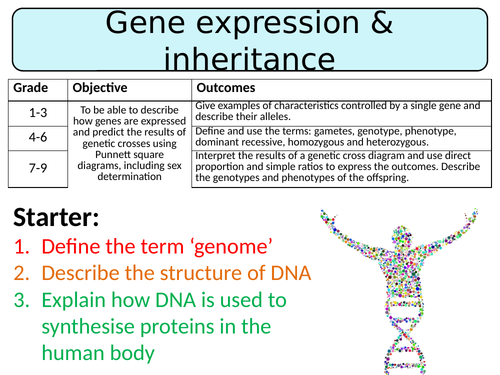
This lesson is designed for the NEW AQA Trilogy Biology GCSE, particularly the ‘Inheritance, variation and evolution’ SoW, it contains some higher-tier only content.
For more lessons designed to meet specification points for the NEW AQA Trilogy specifications for Biology, Chemistry and Physics please see my shop: https://www.tes.com/teaching-resources/shop/SWiftScience
The lesson firstly begins with a description and definition for gene expression in a cell, this leads onto introduce the idea of a mutation. Pupils are given a definition of a mutation and are asked to consider whether mutations are always negative effects. This leads onto show the ways in which a mutation can affect a protein/enzyme in the body and the effect that could have on the function of body processes. Next is a quick check-silent 5 activity to assess students knowledge of gene expression and mutation, pupils can answer the questions in their book and mark their work using the answers provided. There is on further activity on mutations, pupils will watch a video on sickle cell anaemia and answer questions in their books.
The next section of the lesson is on inheritance, firstly pupils are introduced to the idea of alleles and are shown the genotypes of three rabbits with either black or white fur colour to show that it is the combination of alleles that determines this characteristic. Pupils are asked to complete some questions based on what they have learnt so far, which can be assessed using the answers provided.
Next pupils are introduced to the difference between genotype and phenotype, homozygous and heterozygous genotypes. Pupils will then be given a set of images and are asked to identify whether these images are representing a genotype or phenotype, if it is a genotype they are asked to determine if it is homozygous or heterozygous. This work can then be assessed.
Pupils are now shown how to construct a genetic diagram using a worked example, they are then given another genetic cross for which they need to construct their own genetic diagram and work out the percentage of each offspring that would be present, this work can be self-assessed.
The final task is on sex determination, pupils are introduced to the idea of X & Y chromosomes and are shown the combinations needed to produce a male or a female. Pupils will need to construct their own genetic diagram to show the percentage chance of a baby being male or female. This topic can also be assessed using an exam-style questions for higher ability pupils.
The plenary activity is for pupils to write a glossary in the back of their books for any new key words they have learnt this lesson
All resources are included at the end of the presentation. Thanks for looking, if you have any questions please let me know in the comments section and any feedback would be appreciated :)
Get this resource as part of a bundle and save up to 59%
A bundle is a package of resources grouped together to teach a particular topic, or a series of lessons, in one place.
Something went wrong, please try again later.
Waste of money had some stuff I could use but I was looking for a full lesson on gene expression and mutation which it isn't
This is a fab resource.. Saved me a lot of time. But slide number 7 refers to a video and there is no link to it... Can you share what the video is please?
Fantastic resource.
Report this resourceto let us know if it violates our terms and conditions.
Our customer service team will review your report and will be in touch.
